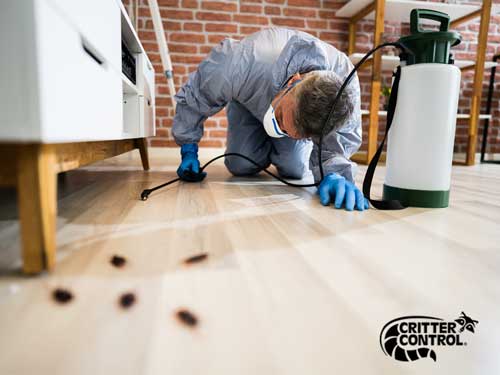Bed Insect Treatment Failure: Comparing Chemical Vs. Non-Chemical Solutions
In the realm of insect control, specifically when handling the persistent issue of bed insects, the choice in between chemical and non-chemical treatment solutions can be a pivotal one. Both strategies provide distinctive advantages and drawbacks, influencing aspects such as effectiveness, safety and security considerations, and general expense. By analyzing the nuanced information of each method, a clearer understanding of which path to seek in attending to a bed pest invasion can be acquired.
Efficiency of Chemical Treatments
Chemical treatments for bed bug infestations have actually been extensively identified for their rapid and powerful effectiveness in removing these bugs. When taking into consideration the performance of chemical therapies, it is critical to recognize that they can give a fast and thorough remedy to a bed pest issue.
In addition, chemical treatments have the benefit of offering recurring impacts, indicating that they can continue to remove bed insects even after the first application. This residual action is particularly useful in combating any type of potential re-infestations. In addition, the quick activity of chemical treatments can bring relief to individuals encountering serious bed bug infestations, permitting them to gain back control of their space rapidly.
Safety Worries With Chemical Solutions
When utilizing chemical services for bed pest therapy is making sure the safety of residents and the setting,One crucial element that needs careful consideration. While chemical therapies can be reliable in removing bed bugs, they may present threats if not dealt with effectively. Among the main safety and security interest in chemical options is the possible injury they can create to human wellness. Exposure to particular chemicals used in bed pest therapies can bring about respiratory system issues, skin irritation, or various other unfavorable reactions, specifically in people with pre-existing problems or level of sensitivities. Additionally, inappropriate application or dosage of chemical pesticides can cause toxic residues remaining in the cured location, positioning long-lasting wellness threats to occupants.
Moreover, the ecological impact of chemical remedies is another substantial factor to consider. Some chemicals utilized in bed bug treatments might be hazardous to useful bugs, wildlife, and ecological communities if they leach into the dirt or water supply. It is essential to use chemical therapies judiciously, complying with security guidelines, and considering much less harmful choices to reduce these dangers and ensure the safe and effective administration of bed pest invasions.
Advantages of Non-Chemical Strategies
Taking into consideration the prospective security worries and environmental impact linked with chemical services for bed insect treatment, discovering non-chemical techniques presents an encouraging alternative with a number of distinct benefits. Non-chemical therapies are ecologically friendly, as they do not add to air or water pollution, making them a sustainable selection for bug control.
Additionally, non-chemical options can be efficient in targeting bed pests, consisting of hard-to-reach areas where chemical treatments may not penetrate - A1 exterminators charlotte nc. Techniques such as warmth treatment, vacuuming, vapor cleansing, and bed mattress encasements supply thorough elimination without the use of damaging chemicals.
Limitations of Non-Chemical Treatments

In addition, non-chemical therapies commonly require numerous applications to accomplish successful removal. This can be time-consuming and might not always assure total removal of all bed insects and their eggs, specifically in concealed or hard-to-reach locations.
Moreover, the success of non-chemical treatments greatly counts on correct application and thoroughness, which can be testing for individuals without expert knowledge. Poor application of non-chemical techniques might result in insufficient eradication, causing consistent infestations and the requirement for added treatments.
As a result, while non-chemical treatments have their benefits, it is necessary to acknowledge these restrictions and consider them when establishing the most effective approach for managing bed insect problems.
Expense Contrast: Chemical Vs. Non-Chemical Options
Given the limitations linked with non-chemical treatments, a vital aspect to assess in the context of bed bug monitoring is the price comparison in between chemical and non-chemical choices. In contrast, non-chemical therapies like warm treatment or vapor can be a lot more expensive, with expenses ranging from $1,000 to $6,000 for a whole home. While the preliminary cost of chemical therapies may seem lower, numerous treatments might be needed to fully eliminate the infestation, possibly enhancing the overall expense.
Conclusion

Considering the possible security worries and ecological impact linked with chemical options for bed bug therapy, exploring non-chemical methods presents an encouraging choice with several unique advantages.Offered the constraints linked with non-chemical treatments, a crucial facet to examine in the context of bed bug administration is the cost comparison in between chemical and non-chemical options. In contrast, non-chemical treatments like warmth treatment or heavy steam can be extra expensive, with expenses ranging from $1,000 to $6,000 for an entire home. While the initial expense of chemical therapies may appear lower, several therapies may be needed to totally eliminate the invasion, possibly enhancing the general price.In conclusion, when contrasting chemical and non-chemical bed pest therapy options, it is crucial to consider efficiency, safety and security, advantages, limitations, and expense.